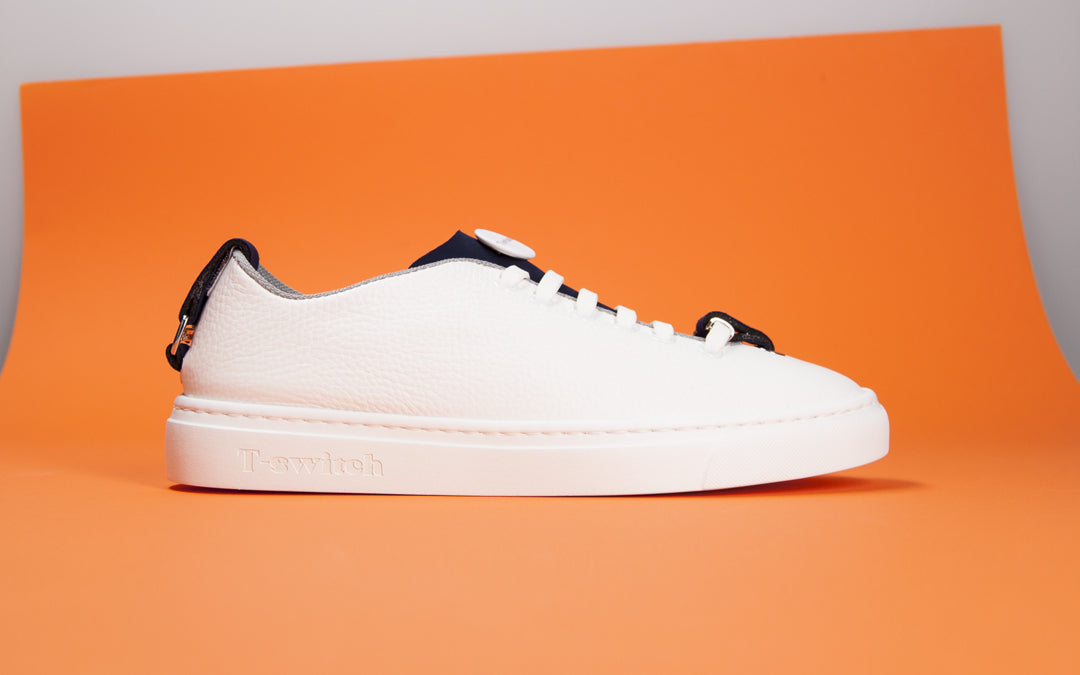
The Evolution of the Sneaker: The “Silent” Shoe That Conquered the World
Share
An urban poem, made of light strides and deep traces, that tells its universe of values without ever uttering a word. We are talking about the sneaker, the shoe that has written its history with a firm step and never looking back. From the dull sound of the rubber to the lightness of the upper, the sneaker is a symphony that celebrates the purest individuality and freedom of expression.
From humble sports shoe to cultural icon it has traveled far and challenged conventions, becoming the beating heart of contemporary fashion. Are you curious to discover the secrets that have made it immortal? Then don't stop here: the best is yet to come!
What is meant by sneaker?

The term "sneaker" comes from the English "to sneak," which literally means "to move silently, furtively" or "to intrude . " The paternity of this word is attributed , according to some sources, to Henry Nelson McKinney, a renowned advertising executive who used it to describe Keds in 1917, ideal for slipping away easily. In this sense, the sneaker evoked the discreet and carefree movements of the wearer, thanks to its sole that provided revolutionary silence.
In the current landscape, sneakers are the ultimate comfy accessory , carving out their own place through design solutions that satisfy different stylistic needs. From leather to fabric, to sustainable innovations, these shoes embody a unique balance between aesthetics and functionality. The sneaker has managed to break away from the concept of “trainers” to establish itself as an evergreen alternative that crosses the barriers between sport and fashion, between practicality and haute couture.
Unlike other walking shoes, sneakers boast greater attention to technical details: advanced cushioning, ergonomic soles and high-performance materials offer incomparable foot well-being and resistance.
Additionally, many sneakers integrate technologies such as improved breathability or posture support, making them perfect for prolonged use throughout the day. This ability to transform and adapt to the needs of every lifestyle further differentiates them from traditional footwear, bringing with it a legacy that continues to influence and redefine the concept of casual, even in a brazenly classy way .
The characteristics of sneakers

High or low, minimalist or with bold textures, made of leather or high-performance fabrics, sneakers have given life to a new way of understanding combinations, where everything seems allowed . They can be paired with a formal suit to create an anarchic but elegant look, or with jeans for a relaxed style , giving a decidedly modern and jaunty aesthetic. Let's see what are the 5 characteristics that make them special:
- Rubber sole - The main feature of a sneaker is the flexible rubber sole, which allows for agile and silent movements.
- Unlimited versatility - Sneakers lend themselves to numerous contexts from urban to formal, depending on the model.
- Premium materials - Leather, technical fabrics or eco-sustainable materials, sneakers offer a perfect mix of luxury and innovation.
- Unisex and ageless - Sneakers are trans-generational and genderless, breaking down barriers to transform every outfit into a statement piece.
- Focus on comfort - More than other shoes, sneakers place an emphasis on comfort, being designed for walking and moving for long periods without sacrificing appeal .
What do you communicate when you wear a sneaker?

If we wanted to understand fashion in Roland Barthes's way, it would be a "system of signification". Individuals, according to his doctrine, dress to exercise their "signifying activity" - to say something about themselves to the world - and this makes our choices in clothing a profoundly social act.
Those who wear sneakers often , for example, suggest a dynamic predisposition and open to change, indicative of a curious, casual and confident personality. The last aspect, in particular, is typical of those who are able to move easily from informal to formal , always remaining in accordance with their personal taste.
Wearing sneakers can also reflect a sense of independence and freedom of expression : people who prefer this type of footwear are not afraid to challenge social rules. Sometimes associated with the world of music, art and sports, sneakers also reveal a connection with metropolitan culture, imbued with a strong desire for authenticity.
Finally, those who opt for sneakers can be seen as someone who appreciates innovation , especially in the case of technologically advanced or eco-friendly models, demonstrating an interest in the future and environmental sustainability.
The history of sneakers

You probably realized only now that yes, sneakers are incredibly silent and it is natural not to have given it weight. The lever that pushes you to prefer these shoes is often linked more to aesthetics than to other factors. The second “surprise moment”, however, comes now because their history is full of charm and much older than you might imagine.
The roots of sneakers date back to the 16th century, when Native Americans covered their soles with natural latex to protect their feet from harsh terrain . A simple but ingenious idea, which heralded the future of a shoe that was destined to revolutionize the world. However, the real turning point came only in 1839, with the invention of the vulcanization process by Charles Goodyear . This method allowed rubber to be transformed into a more resistant and elastic material, marking the dawn of the modern sports shoe. Shortly after, in 1850, the first rubber sole was created in England , welcomed with enthusiasm by the aristocracy who used it for outdoor gymnastic activities.
The beginning of the 20th century marked the global rise of sneakers. During the 1896 Athens Olympics, many athletes wore them to improve their performance, making them famous internationally. Since then, sneakers have continued to evolve, becoming a symbol of performance and athletic success. An indelible example is Jesse Owens, who during the 1936 Berlin Olympics won four gold medals wearing Adidas, a brand founded in 1924 by Adi Dassler.
In the 50s and 60s, sneakers acquired a rebellious aura , becoming the instrument of a youth counterculture in search of freedom. Famous movie stars like James Dean wore them on the big screen. From that moment on, these shoes identified a statement .
During the 1970s, sneakers gained iconic status . The hip-hop movement and the rise of streetwear took them from the sports field to the streets, while collaborations with world-famous talents in the 1980s transformed them into cult objects. The most emblematic example is represented by Nike's Air Jordan, launched in 1984 in collaboration with Michael Jordan.
In the 90s, they established themselves as a symbol of casual luxury, with the introduction of innovations such as airbag cushioning in the soles (see the Nike Air Max). Today, sneakers represent much more than a sports accessory: they are the distinctive detail of globetrotters and trendsetters . High fashion brands such as Gucci, Balenciaga and Chanel have further elevated their message: they are no longer a simple street item, but can also access the golden Olympus of the fashion system .
Key Moments in Sneaker History
After having dwelt at length on the history of sneakers, we leave you with a small recap of the 10 fundamental stages in the genesis of this icon.
- 16th century : Native Americans protect their feet with latex, the first prototype of a "rubber sole".
- 1839 : Charles Goodyear invents vulcanization, revolutionizing the production of durable soles.
- 1850 : The first rubber-soled gym shoe is made in England.
- 1896 : At the Athens Olympics, sneakers become a globally renowned sports shoe.
- 1917 : Advertiser McKinney invents the term “sneakers” and, at the same time, the Converse All-Star is born, destined to become a symbol of youth culture.
- 1924 : Adi Dassler founds Adidas, a brand that will mark the history of sports shoes.
- 1936 : Jesse Owens wins four gold medals at the Berlin Olympics wearing sneakers.
- 1950s : Sneakers become a symbol of rebellion and independence, thanks to icons like James Dean.
- 1984 : Nike launches the Air Jordan, changing the sneaker landscape forever.
- 1990s : The adoption of advanced technologies and the rise of streetwear cement sneakers as a global status symbol .
Today, sneakers represent a concentration of stories of innovation, rebellion and popular culture. A legacy that, undoubtedly, is destined to continue.

Sneakers: a cultural phenomenon
Now that you have reached the finish line, you will have understood that it is limited to define sneakers as simple shoes. They are an ode to dynamism and individuality, a cultural fact that has been able to cross generations, influencing music, art and fashion in every corner of the planet. From catwalks to urban asphalts, they have become the symbol of a fluid, cosmopolitan and avant-garde lifestyle.
Brands like T-Switch, with the multiple customization possibilities offered by T-Kits give you the key to reveal your uniqueness , demonstrating how this accessory has transcended the boundaries of time. Sneakers are the answer to the changes of a society in constant movement and their journey, like fashion itself, knows no end.
